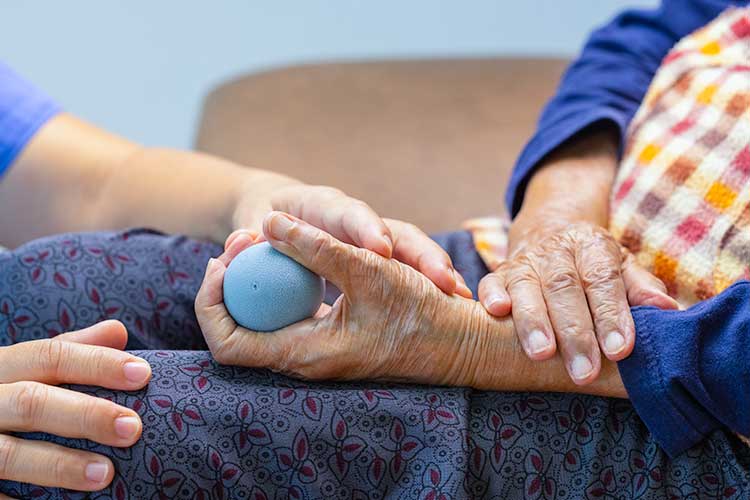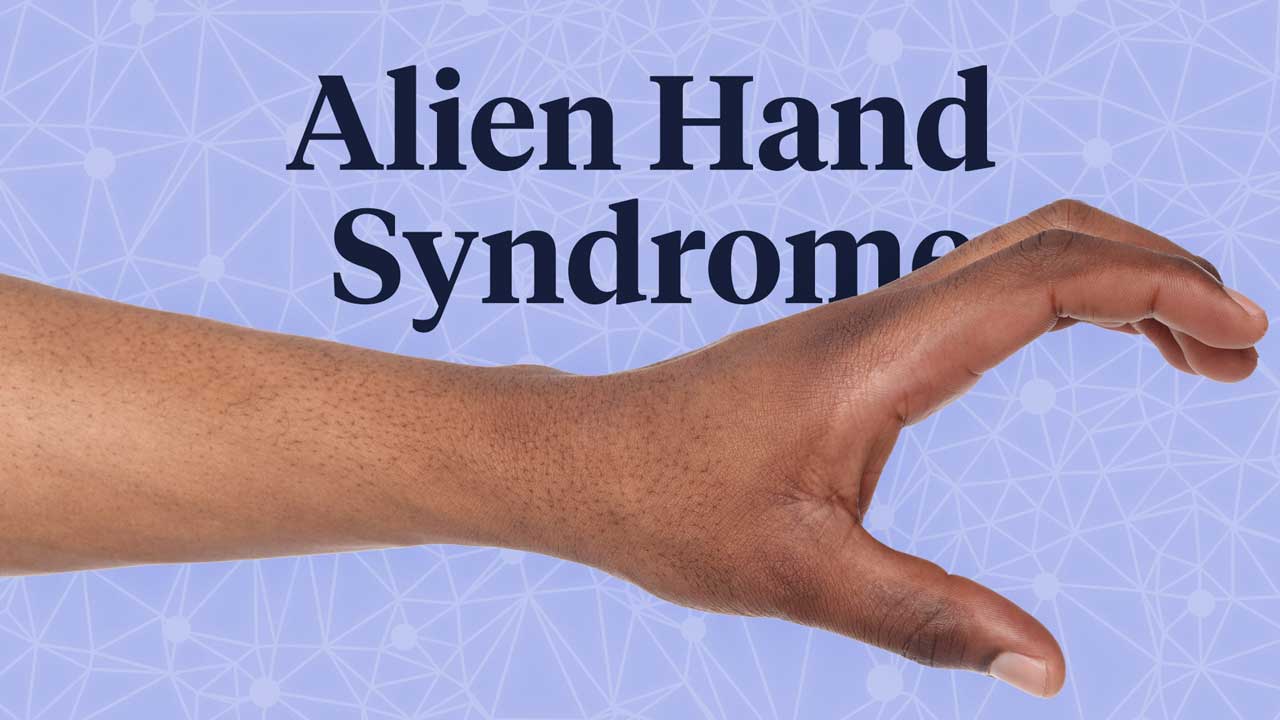How would you feel if one of your hands began to move and perform actions on its own, and you were completely unable to control it?
It would surely be a highly distressing and frustrating experience.
As bizarre as it sounds, this condition, known as alien hand syndrome, is a very real and disabling, albeit rare, complication of certain neurological pathologies.
So, what exactly is this phenomenon, and why does it occur?
What is Alien Hand Syndrome?
Alien hand syndrome (AHS) is a rare neurological disorder in which a person experiences involuntary, purposeful limb movements without any conscious intention of performing them (Bru et al. 2021; Cleveland Clinic 2025).
Rather than spasms or convulsions, these involuntary movements are purposeful, coordinated and goal-directed actions that appear as if the limb is being controlled by another person (Cleveland Clinic 2025).
AHS has only been observed to affect one limb at a time, and while it typically affects the hand, there have been cases of similar symptoms occurring in the legs (Anderson 2024).
Individuals with AHS often feel a loss of ownership and control over their affected limb, with many describing it as having ‘a mind of its own’. Some patients even speak about their limb in the third person (Fitzgerald 2021).
The condition is sometimes referred to as ‘Dr Strangelove syndrome’, based on the 1964 movie Dr Strangelove, wherein the titular character experiences AHS (Helmstaedter et al. 2021).
What Causes Alien Hand Syndrome?
AHS is associated with damage to parts of the brain caused by:
- Stroke
- Trauma
- Brain tumours
- Cancer
- Neurodegenerative diseases, e.g. Parkinson’s disease, Alzheimer's disease
- Brain aneurysms
- Neurosurgery, e.g. corpus callosotomy.
(Cleveland Clinic 2025; Anderson 2024)
More research is needed in order to fully understand why AHS occurs (Anderson 2024).
Types of Alien Hand Syndrome
AHS appears to be associated with injury to one of three specific regions of the brain. These are:
- The frontal lobe (frontal AHS)
- The corpus callosum (callosal AHS)
- The parietal lobe (posterior AHS).
(Anderson 2024)
Symptoms of Alien Hand Syndrome

People with AHS may experience a variety of involuntary movements from the affected limb, such as:
- Self-groping (e.g. touching the face)
- Goal-directed tasks (e.g. buttoning up a shirt)
- Grasping objects
- Refusal to release held objects
- Levitating (rising into the air)
- Less purposeful movements like waving around.
(Cleveland Clinic 2025; Anderson 2024)
The patient might display autocriticism in response to these involuntary movements, for example, slapping the ‘alien’ hand with their unaffected hand (Bru et al. 2021).
AHS seems to present differently depending on the area of the brain that has been injured. For example, damage to one side of the frontal lobe often causes the hand on the opposite side of the body to perform purposeful movements such as reaching and grasping, and the person might have difficulty releasing an object being held. Posterior injury seems to cause the affected limb to withdraw rather than reach, and it may ‘levitate’ upward and away from surfaces. Corpus callosum injury appears to affect the person’s non-dominant hand and causes intermanual conflict (where the hands perform opposing actions) (Anderson 2024; Bionity n.d.).
Diagnosis of Alien Hand Syndrome
AHS is difficult to diagnose for several reasons:
- It’s a neurological condition without a psychiatric component
- It may be misdiagnosed as a psychiatric disorder or behavioural issue due to its rarity
- There are very few reported cases of AHS in literature, so healthcare practitioners may be unfamiliar with the condition.
(Anderson 2024; Moawad 2016)
Consequently, diagnosis requires thorough observation and evaluation of symptoms, as well as patient history, clinical examination and an MRI scan to look for lesions in the brain (Moawad 2016; Fitzgerald 2021).
Treatment for Alien Hand Syndrome
There is no specific cure for AHS, but symptoms may resolve on their own. This has been found to take anywhere between 30 minutes to several years (Cleveland Clinic 2025).
There are a variety of treatments that have been attempted with varying degrees of success, but many of these are based on anecdotal evidence only. They include:
- Cognitive therapies
- Medications, e.g. neuromuscular blocking agents, anticonvulsants
- Botulinum toxin injections (botox)
- Mirror box therapy
- Learning task behavioural therapies
- Visuospatial coaching
- Physical and occupational therapies
- Distracting the affected limb by having it hold something
- Patient-initiated restriction of the affected limb (e.g. sitting on it, wearing an oven mitt)
- Giving verbal commands to the affected limb.
(Cronkleton 2018; Anderson 2024; Cleveland Clinic 2025)
Caring for Patients With Alien Hand Syndrome

When caring for a patient who is experiencing AHS, you may wish to consider the following strategies:
- Keeping the patient’s affected hand occupied (e.g. with a stress or tennis ball) when working in close proximity to them
- Ensuring the environment is clutter-free and that objects are not in reach of the affected hand (this reduces the risk of accidents)
- Creating a calm and stress-free environment (e.g. accommodating the patient in a single room, which also promotes sleep hygiene)
- Using visualisation tactics such as positioning the affected hand within the patient's visual field and encouraging the patient to mentally practise functional tasks using both limbs
- Minimising distractions for the patient when providing care or therapy
- Managing fatigue by scheduling therapy and care throughout the day, depending on the patient’s fatigue levels.
In the event of a patient griping or groping a staff member, patience is required in managing the incident. If required, release the patient's grip gently by prising off the pinky and ring fingers, followed by the remaining fingers. Pulling away or forcing the release will, in many instances, only increase the force of the grip. Panic will increase anxiety for both the staff member and the patient, which could exacerbate the situation further.
Conclusion
Remember that AHS is an often frustrating and disabling condition that can be highly distressing for patients. It’s therefore essential to provide empathetic and patient care to these individuals.
Test Your Knowledge
Question 1 of 3
What is the defining characteristic of alien hand syndrome?
Topics
References
- Anderson, A 2024, What Is Alien Hand Syndrome?, WebMD, viewed 11 June 2025, https://www.webmd.com/brain/what-is-alien-hand-syndrome
- Bionity n.d., Alien Hand Syndrome, LUMITOS, viewed 11 June 2025, https://www.bionity.com/en/encyclopedia/Alien_hand_syndrome.html
- Bru, I, Verhamme, L, de Neve, P & Maebe, H 2021, ‘Rehabilitation of a Patient with Alien Hand Syndrome: A Case Report of a 61-Year Old Man’, Journal of Rehabilitation Medicine - Clinical Communications, vol. 4, viewed 11 June 2025, https://europepmc.org/article/pmc/pmc8054745
- Cleveland Clinic 2025, Alien Hand Syndrome, Cleveland Clinic, viewed 11 June 2025, https://my.clevelandclinic.org/health/diseases/alien-hand-syndrome
- Cronkleton, E 2018, ‘What Is Alien Hand Syndrome?’, Healthline, 18 September, viewed 25 May 2022, https://www.healthline.com/health/alien-hand-syndrome
- Fitzgerald, S 2021, ‘What is Alien Hand Syndrome?’, Brain Wonders, viewed 11 June 2025, https://www.brainandlife.org/articles/what-is-alien-hand-syndrome
- Helmstaedter, C, Solymosi, L, Kurthen, M et al. 2021, ‘Dr. Strangelove Demystified: Disconnection of Hand and Language Dominance Explains Alien-Hand Syndrome After Corpus Callosotomy’, Seizure, vol. 86, viewed 11 June 2025, https://www.sciencedirect.com/science/article/pii/S1059131121000479
- Moawad, H 2016, ‘Alien Hand Syndrome’, NeurologyLive, 17 August, viewed 11 June 2025, https://www.neurologylive.com/view/alien-hand-syndrome
 New
New 
